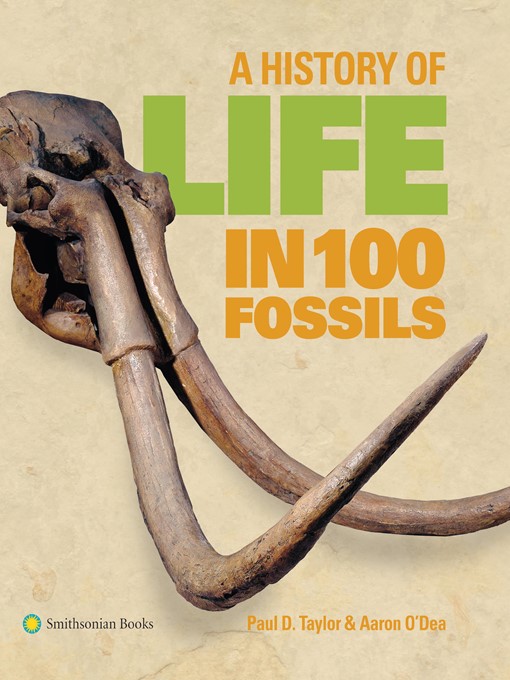-
Creators
-
Publisher
-
Release date
October 14, 2014 -
Formats
-
Kindle Book
-
OverDrive Read
- ISBN: 9781588345028
- File size: 94442 KB
-
EPUB ebook
- ISBN: 9781588345028
- File size: 94442 KB
-
-
Languages
- English
-
Reviews
-
Publisher's Weekly
October 13, 2014
Through a combination of informative text and striking pictures, Taylor and O'Dea, of the Natural History Museum, London, and the Smithsonian Tropical Research Institute, respectively, present an overview of the evolution of life on Earth. Using some of the notable fossils present in the collections of the Natural History Museum and the Smithsonian, they describe life forms ranging from 3.5 billion-year-old cyanobacteria to the Stellar's sea cow, which was driven to extinction in the late 18th century. Each picture is coupled with a brief description and readers are treated to a discussion of what evolutionary lessons can be learned from each fossil. (The book's only major downside is that the fossils are presented without a clear indication of scale, so it is difficult to appreciate size differences.) In addition to such standard fare as descriptions of how Archaeopteryx displays both bird and reptile characteristics, the authors go further afield, demonstrating, for example, that grasses were common many millions of years earlier than originally hypothesized. The fossils Taylor and O'Dea present lead them to wonder about such issues as the nature of symbiosis or whether all dinosaurs were warm-blooded, using their material like any good scientist: to ask as many questions as they answer. -
Kirkus
July 15, 2014
Not a history of life as much as a picture book with 100beautiful photographs of fossils, each accompanied by a pagelong essay on itsrole in evolution.Paleontologists Taylor (co-author: FossilInvertebrates, 2005, etc.), who has worked for three decades at the NaturalHistory Museum in London, and O'Dea, a staff scientist at the SmithsonianTropical Research Institute in Panama, emphasize that a minuscule fraction ofthe bones, shells, teeth, stems and leaves of extinct life survives as fossils,and even fewer soft body parts, stomach contents, feces, eggs, embryos andnests. However, a minuscule fraction of trillions is still a superabundance,from which the authors have chosen the creme de la creme. Life began less than1 billion years after the Earth cooled 4.5 billion years ago. The earliest lifeforms may resemble bacteria, and the book's first photograph of rockscontaining microscopic, branched filaments will impress general readers asexamples of primitive life. Matters quickly improved, illustrated by thefollowing photograph, a swirling mass of stromatolites, layered deposits ofbacteria that spread over the oceans 3.5 billion years ago. They producedoxygen, which, after a few billion years, led to the explosion of complex,multicellular, oxygen-breathing organisms 600 million years ago. The followingpictures reveal odd, soft-bodied floating blobs that evolved into creaturesthat crawled, swam, spread onto land a few hundred million years later, anddeveloped into familiar reptiles, mammals and primates.Despite the terrific photographs, the avalanche ofinformation in the text may overwhelm beginners, who should read a genuinehistory of evolution-e.g., Richard Fortey's Life (1998)-beforedipping into this treasure trove.COPYRIGHT(2014) Kirkus Reviews, ALL RIGHTS RESERVED.
-
Library Journal
July 1, 2014
As intriguing remnants of the geologic past, every fossil tells a story about the evolution of life on Earth. Paleontologist Taylor (Natural History Museum, London) and paleobiologist O'Dea (Smithsonian Tropical Research Inst., Panama) have assembled information on 100 fossils that showcases the enormous diversity of life forms that have come and gone since life began in the seas 3.5 billion years ago. For each fossil there is a photograph accompanied by a lively single-page essay describing the organism's anatomical features, diet, lifestyle, taxonomic classification, and evolutionary significance. With only ten fossil plants included, the collection is heavily weighted toward animal species. Although the photographs are of high quality, labeling of each fossil's prominent features would have been helpful for understanding the configuration of less familiar species; a scale of measurement would have been handy as well. VERDICT From single-celled foraminifera to gigantic steppe mammoths, this volume presents a sweeping panorama of ancient life and is recommended for nonspecialists interested in paleontology or evolutionary biology. A solid companion to Donald Prothero's Evolution: What the Fossils Say and Why It Matters.--Cynthia Lee Knight, formerly with Hunterdon Cty. Lib., Flemington, NJ
Copyright 2014 Library Journal, LLC Used with permission.
-
Formats
- Kindle Book
- OverDrive Read
- EPUB ebook
subjects
Languages
- English
Loading
Why is availability limited?
×Availability can change throughout the month based on the library's budget. You can still place a hold on the title, and your hold will be automatically filled as soon as the title is available again.
The Kindle Book format for this title is not supported on:
×Read-along ebook
×The OverDrive Read format of this ebook has professional narration that plays while you read in your browser. Learn more here.



